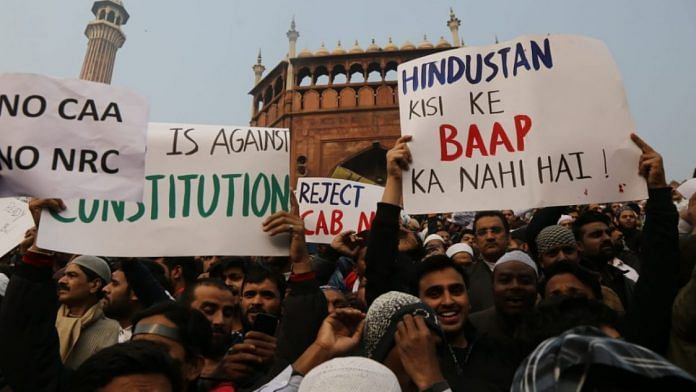New Delhi: As many as 27 protesters allegedly involved in the December 2019 protests against the Citizenship Amendment Act (CAA) in Uttar Pradesh have been booked under the UP Gangsters and Anti-Social Activities (Prevention) Act 1986 by the Yogi Adityanath administration.
Brought under a Congress-led government, the law has been controversial from the start.
According to a 13 March press note released by police in Lucknow, one of the epicentres of the protests, the protesters have been slapped with the gangsters Act because investigations had confirmed that they “conspired as a gang to commit anti-government activities… thereby causing panic among the public”.
ThePrint takes a look at the origin and provisions of the Act, and the sections that have been invoked against the accused.
Also Read: SC says there is no law to back UP govt on ‘name and shame’ posters of anti-CAA protesters
Why was the Act enacted?
The UP Gangsters and Anti-Social Activities (Prevention) Act, 1986, was brought in by the then Congress government, led by chief minister Vir Bahadur Singh, in 1986. The main aim of the Act was to bring to book the 2,500 known gangsters in the state at the time.
It defines a gangster as “a member or leader or organiser of a gang and includes any person who abets or assists in the activities of a gang enumerated in clause (b), whether before or after the commission of such activities or harbours any person who has indulged in such activities”.
Clause b defines several illegal activities, such as unauthorised liquor trade, disturbing communal harmony and preventing or attempting to prevent any public servant or any witness from discharging his lawful duties.
However, within six months, the state government stopped invoking the law as certain legal loopholes came to light, including its generalised definition of gangsters and a provision that was allowing easy bail.
The Act was brought into force in January 1986, and by September, 475 of the 771 alleged gangsters arrested under it had successfully secured bail.
Why was it invoked against anti-CAA protesters?
The 27 people booked under the Act have been accused of firing at police with an “intention to kill” and setting a police outpost on fire in Lucknow’s Satkhanda area.
They have also been accused of damaging and looting other government offices and setting public/private vehicles on fire.
What are the sections invoked?
Lucknow police have invoked Section 2(b) and Section 3 of the gangsters Act against the 27 protesters.
Section 2(b) of the Gangster Act defines a “gang” and prescribes a detailed list of “anti-social activities” punishable under the Act. These include resorting to violence to disturb communal harmony and creating panic, alarm or terror in public.
Section 3 of the Act prescribes that a “gangster” shall be punished with imprisonment of either two years (three years in case the offence is committed against a public servant), which may extend to 10 years and also face a fine.
However, these were the very sections that came under a cloud right after the Act was passed.
In April 1986, after the Act was challenged in court, the Allahabad High Court ordered judges to ignore sections 2 and 3 in considering the question of bail.
The bench that issued the order comprised Justice Sagir Ahmed and Justice B.L. Lumba, who was involved in the formulation of the Act as the state’s erstwhile law secretary.
Mata Prasad, the then UP home secretary, was subsequently quoted as saying that “the court order amounted to striking down the Act without saying so”.
The government appealed against the order in the Supreme Court, which then stayed the high court decision.
The people booked under the Act over the years
Not only protesters, the 1986 legislation has also been invoked against land mafia and journalists.
In January last year, Noida police invoked the Act against five suspected members of the land mafia who illegally sold plots to gullible buyers along the flood-prone banks of the Yamuna river.
Since April 2017, a month after the Yogi Adityanath-led BJP government took office, the administration has reportedly invoked the gangsters Act against more than 600 “anti-social” elements, including drug and liquor mafia and rogue builders.
In August 2019, five men who identified themselves as journalists, including three out on bail in a corruption case, were booked under the Act for allegedly circulating fake news on their portals to put pressure on government officials and prevent them from performing their duty.
Gautam Buddh Nagar police had said at the time that the accused were trying to create pressure on police in connection with the corruption case, which is in court, and listed 10 “motivated” news articles released by them.
In 2015, one Juned Ahmad was charged under the Act for committing an alleged offence under the UP Cow Slaughter Act 1955.
Later, when this order was challenged, the Allahabad High Court said police authorities had no jurisdiction to invoke the gangsters Act on the ground that the accused had committed an offence under the Cow Slaughter Act.
The anti-CAA protests in Uttar Pradesh after the law’s passage in December led to widespread protests, which led to the death of nearly 20 people.
Also Read: In UP, 1,000 women booked in 8 FIRs as Lucknow, Prayagraj host their own Shaheen Bagh






